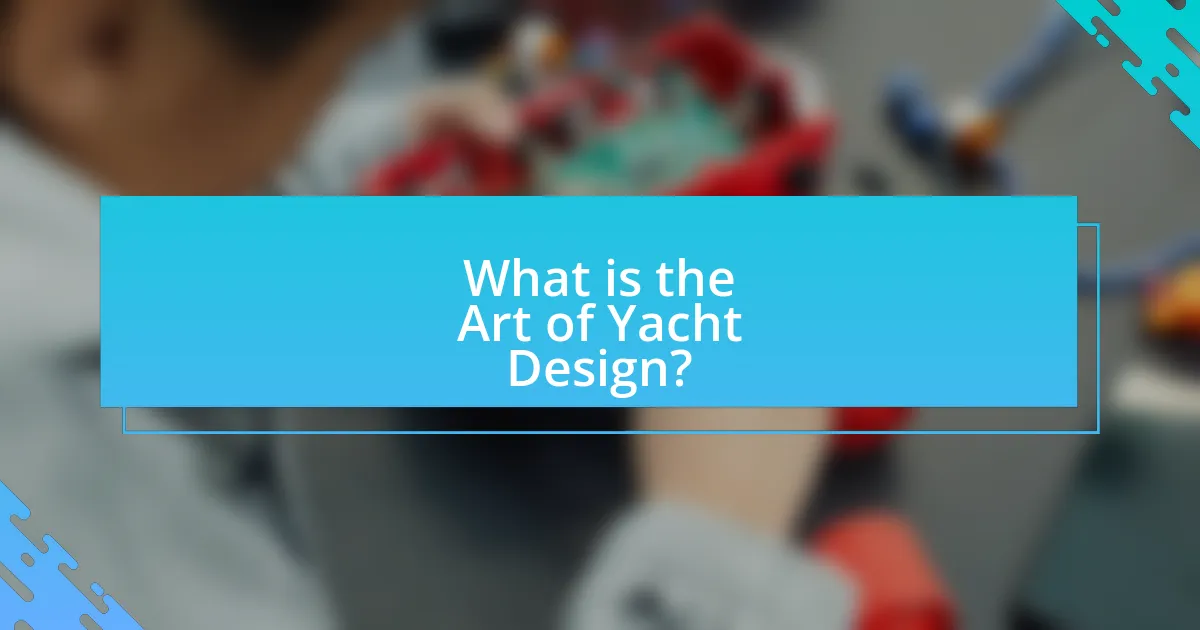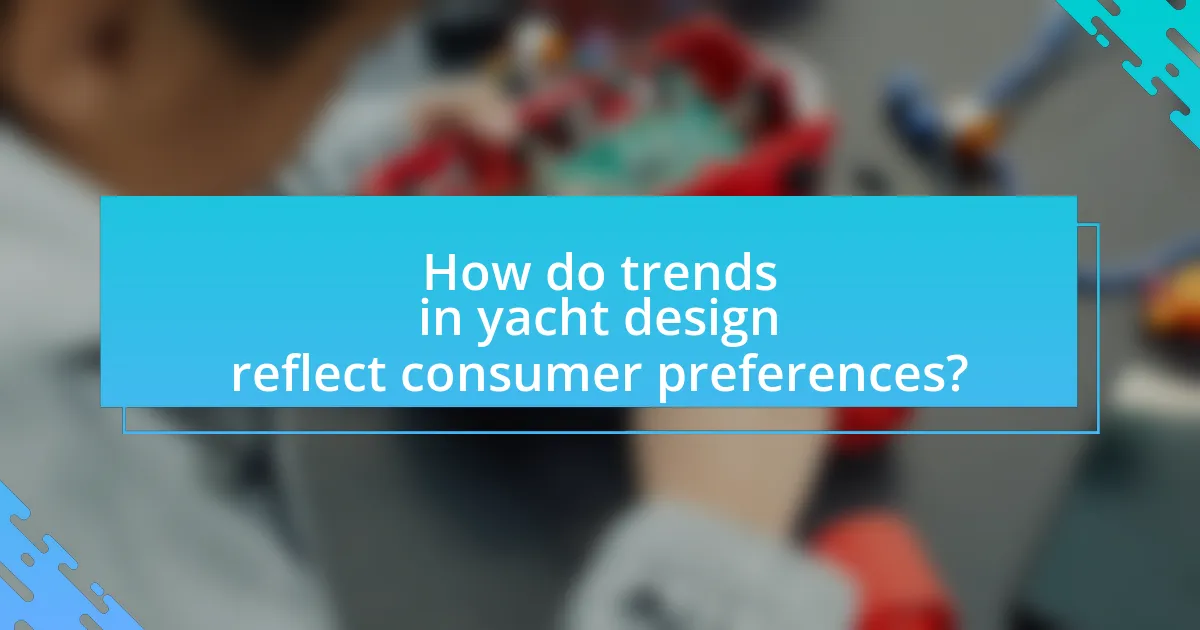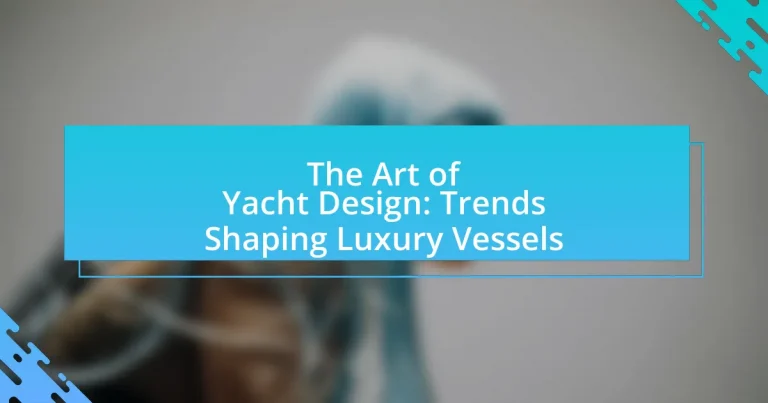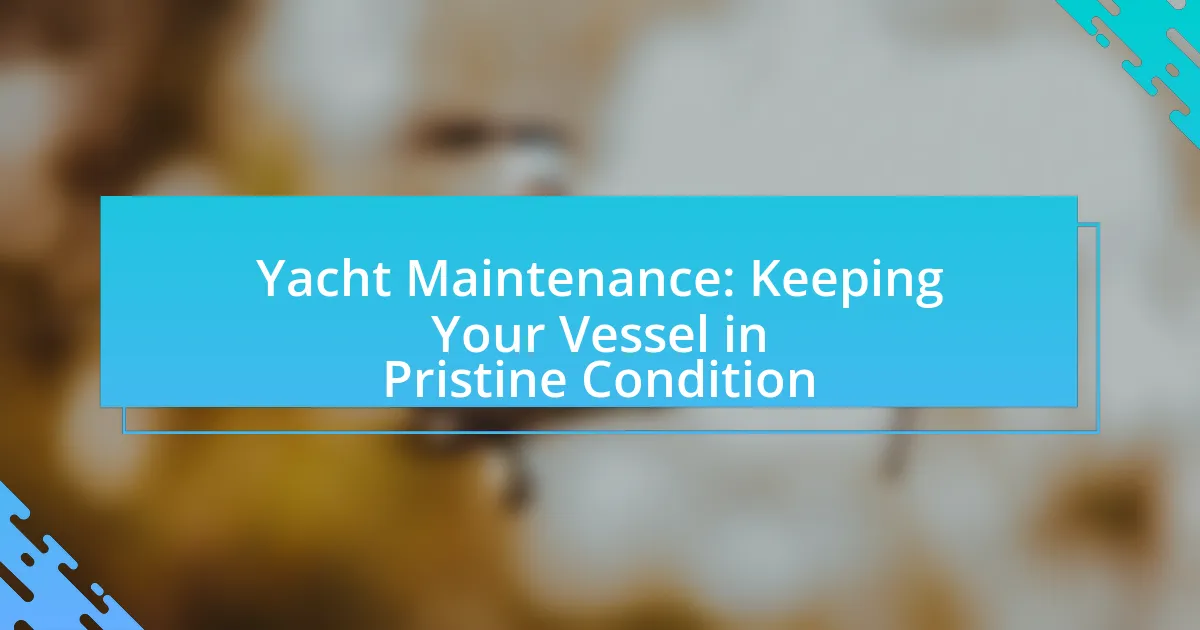The main entity of the article is yacht design, specifically focusing on the trends shaping luxury vessels. The article explores the intricate process of yacht design, highlighting the evolution from traditional sailing yachts to modern motor yachts, and the integration of sustainability and advanced technologies. Key elements discussed include the influence of historical contexts, cultural trends, and consumer preferences on design choices, as well as the importance of functionality and aesthetics. Additionally, the article addresses the challenges faced by designers, regulatory considerations, and the impact of economic factors on yacht design trends, providing a comprehensive overview of the current landscape in luxury yacht design.

What is the Art of Yacht Design?
The Art of Yacht Design is the intricate process of creating luxury vessels that blend aesthetics, functionality, and performance. This discipline involves a deep understanding of naval architecture, engineering, and design principles to produce yachts that are not only visually appealing but also seaworthy and efficient. Historical examples, such as the evolution of yacht design from classic sailing yachts to modern motor yachts, illustrate how innovation and technology have continuously shaped this art form. Additionally, the integration of sustainable materials and advanced technologies in contemporary yacht design reflects current trends and consumer preferences, emphasizing the importance of environmental considerations in the luxury market.
How has yacht design evolved over the years?
Yacht design has evolved significantly over the years, transitioning from traditional sailing vessels to modern luxury motor yachts. Initially, yachts were primarily functional, designed for speed and efficiency in sailing, as seen in the early 20th century with designs like the J-Class yachts, which emphasized performance in competitive sailing.
As technology advanced, particularly with the introduction of fiberglass in the 1960s, yacht design began to incorporate more innovative materials and construction techniques, allowing for greater customization and luxury features. The 1980s and 1990s saw a shift towards larger, more opulent designs, with an emphasis on comfort and amenities, reflecting the growing demand for luxury experiences on the water.
In recent years, yacht design has increasingly focused on sustainability and eco-friendliness, with the integration of hybrid propulsion systems and energy-efficient technologies. This evolution is evident in the rise of superyachts that not only prioritize luxury but also environmental responsibility, showcasing a blend of cutting-edge design and ecological awareness.
What historical influences have shaped modern yacht design?
Modern yacht design has been significantly shaped by historical influences such as naval architecture advancements, the Age of Exploration, and the evolution of leisure boating. Naval architecture, particularly during the 19th century, introduced innovations like steam propulsion and hull design, which improved speed and stability. The Age of Exploration, spanning the 15th to 17th centuries, emphasized the importance of seaworthiness and functionality, leading to designs that prioritized both performance and luxury. Additionally, the rise of leisure boating in the late 19th and early 20th centuries, driven by the affluent class, shifted focus towards aesthetics and comfort, resulting in the opulent designs seen in modern yachts today. These historical contexts collectively inform the principles and styles that define contemporary yacht design.
How do cultural trends impact yacht design styles?
Cultural trends significantly influence yacht design styles by dictating aesthetics, functionality, and materials used in construction. For instance, the rise of sustainability as a cultural priority has led to an increased demand for eco-friendly materials and energy-efficient technologies in yacht design, such as solar panels and hybrid propulsion systems. Additionally, the popularity of minimalism in contemporary design has resulted in yachts featuring clean lines, open spaces, and multifunctional areas, reflecting a shift towards simplicity and practicality. Historical context supports this, as the 2008 financial crisis prompted a move away from ostentatious luxury towards more understated elegance in yacht design, aligning with broader societal values of moderation and sustainability.
What are the key elements of yacht design?
The key elements of yacht design include hull shape, interior layout, materials, and propulsion systems. Hull shape affects performance, stability, and aesthetics; for example, a streamlined hull enhances speed and fuel efficiency. Interior layout focuses on maximizing space and comfort, often incorporating luxury amenities tailored to owner preferences. The choice of materials, such as fiberglass, aluminum, or wood, influences durability and maintenance. Propulsion systems, whether sail or motor, determine the yacht’s operational capabilities and environmental impact. Each of these elements plays a crucial role in creating a functional and luxurious vessel that meets the demands of modern yachting.
What role does functionality play in yacht design?
Functionality is a critical aspect of yacht design, as it directly influences the usability, comfort, and performance of the vessel. Effective yacht design prioritizes functionality to ensure that spaces are optimized for various activities, such as dining, relaxation, and navigation. For instance, the layout of a yacht often includes multifunctional areas that can adapt to different needs, enhancing the overall experience for passengers. Additionally, the integration of advanced technology, such as navigation systems and energy-efficient engines, exemplifies how functionality drives innovation in yacht design, ensuring safety and sustainability. This focus on functionality not only meets the practical demands of yacht owners but also aligns with industry trends that emphasize user experience and environmental responsibility.
How do aesthetics influence the design of luxury vessels?
Aesthetics significantly influence the design of luxury vessels by dictating visual appeal, functionality, and overall user experience. Designers prioritize sleek lines, elegant materials, and harmonious color palettes to create an inviting atmosphere that reflects luxury and sophistication. For instance, the use of high-quality woods, polished metals, and expansive glass surfaces enhances both the aesthetic and functional aspects of the vessel, allowing for natural light and panoramic views. Additionally, trends such as minimalism and eco-friendly designs have emerged, emphasizing clean aesthetics while promoting sustainability. This focus on aesthetics not only attracts affluent buyers but also sets industry standards, as seen in the designs of renowned yacht builders like Feadship and Lürssen, which consistently showcase innovative and visually striking vessels.
What are the current trends in yacht design?
Current trends in yacht design emphasize sustainability, innovative technology, and personalized luxury. Designers are increasingly incorporating eco-friendly materials and energy-efficient systems, such as hybrid propulsion and solar panels, to reduce environmental impact. Additionally, advancements in smart technology allow for enhanced automation and connectivity, improving user experience and operational efficiency. Customization is also a significant trend, with clients seeking unique designs that reflect their personal style and preferences, leading to bespoke interiors and layouts. These trends are supported by industry reports indicating a growing demand for sustainable and technologically advanced yachts, reflecting a shift in consumer priorities towards environmental responsibility and personalized luxury experiences.
How is sustainability influencing yacht design today?
Sustainability is significantly influencing yacht design today by driving the adoption of eco-friendly materials and energy-efficient technologies. Designers are increasingly utilizing sustainable materials such as recycled aluminum and bio-based composites, which reduce environmental impact. Additionally, advancements in renewable energy systems, like solar panels and hybrid propulsion, are being integrated into yacht designs to minimize fuel consumption and emissions. According to a report by the International Maritime Organization, the maritime industry aims to reduce greenhouse gas emissions by at least 50% by 2050, prompting yacht manufacturers to innovate in sustainable practices. This shift not only meets regulatory demands but also aligns with the growing consumer preference for environmentally responsible luxury products.
What technological advancements are shaping modern yachts?
Technological advancements shaping modern yachts include the integration of hybrid propulsion systems, advanced materials, and smart technology. Hybrid propulsion systems, which combine traditional engines with electric motors, enhance fuel efficiency and reduce emissions, aligning with global sustainability trends. Advanced materials like carbon fiber and lightweight composites improve performance and durability while reducing weight. Smart technology, including IoT devices and automation systems, allows for enhanced navigation, monitoring, and control, providing a more user-friendly experience. These advancements collectively represent a significant evolution in yacht design, catering to both performance and luxury demands in the industry.

How do trends in yacht design reflect consumer preferences?
Trends in yacht design reflect consumer preferences by prioritizing sustainability, technology integration, and personalized luxury. As consumers increasingly value eco-friendly options, yacht manufacturers are incorporating sustainable materials and energy-efficient systems, such as hybrid propulsion and solar panels. For instance, the global yacht market has seen a rise in demand for eco-conscious designs, with a 20% increase in orders for hybrid yachts reported in 2022. Additionally, advancements in technology have led to smart yacht features, allowing owners to control various systems remotely, aligning with consumer desires for convenience and modernity. Furthermore, customization options have expanded, enabling buyers to tailor designs to their specific tastes, which is evident in the growing trend of bespoke interiors and layouts. This shift towards personalization is supported by a 30% increase in custom yacht orders over the past five years, demonstrating a clear alignment between design trends and consumer expectations.
What features are luxury yacht buyers looking for?
Luxury yacht buyers are primarily looking for advanced technology, high-quality materials, and personalized design features. Advanced technology includes state-of-the-art navigation systems, smart home automation, and eco-friendly propulsion systems, which enhance both safety and efficiency. High-quality materials such as teak wood, stainless steel, and luxury fabrics contribute to the yacht’s aesthetic and durability. Personalized design features, including custom layouts, unique interior designs, and bespoke amenities like spas and gyms, cater to individual preferences and lifestyles. These elements reflect current trends in luxury yacht design, emphasizing comfort, sustainability, and innovation.
How do lifestyle changes affect yacht design choices?
Lifestyle changes significantly influence yacht design choices by shifting priorities towards sustainability, technology integration, and multifunctional spaces. As consumers increasingly prioritize eco-friendliness, yacht designers are incorporating sustainable materials and energy-efficient systems, such as solar panels and hybrid propulsion. Additionally, the rise of remote work has led to a demand for onboard office spaces and high-speed internet connectivity, prompting designers to create layouts that accommodate both leisure and professional activities. Furthermore, the trend towards wellness and health has resulted in the inclusion of features like gyms, spas, and open-air living areas, reflecting a lifestyle that values relaxation and well-being. These design adaptations are supported by market research indicating that over 60% of yacht buyers now consider environmental impact and onboard functionality as key factors in their purchasing decisions.
What amenities are becoming standard in luxury vessels?
Luxury vessels are increasingly incorporating amenities such as expansive outdoor spaces, state-of-the-art entertainment systems, and wellness facilities. These features enhance the onboard experience, catering to the desires of affluent clients. For instance, many modern yachts now include infinity pools, spas, and gyms, reflecting a trend towards health and relaxation. Additionally, advanced technology like smart home systems and high-speed internet connectivity has become essential, allowing for seamless integration of entertainment and communication. The incorporation of these amenities is supported by market research indicating that luxury yacht buyers prioritize comfort and modern conveniences, driving the evolution of yacht design.
How do designers incorporate personalization in yacht design?
Designers incorporate personalization in yacht design by tailoring features to the owner’s preferences, including custom layouts, materials, and technology. This process often begins with consultations to understand the owner’s lifestyle and aesthetic desires, allowing designers to create unique spaces that reflect individual tastes. For instance, high-end yacht builders like Feadship and Lürssen offer bespoke options such as personalized interior designs, custom furniture, and specialized amenities like spas or gyms, ensuring that each yacht is a true reflection of its owner’s identity. This level of customization not only enhances the owner’s experience but also adds significant value to the vessel, as evidenced by the growing trend of bespoke yacht builds in the luxury market.
What customization options are available for yacht owners?
Yacht owners have a variety of customization options available, including interior design, exterior aesthetics, and technological enhancements. Interior design can be tailored with bespoke furnishings, personalized layouts, and unique materials, allowing owners to create spaces that reflect their personal style. Exterior aesthetics can be customized through paint schemes, hull designs, and deck layouts, enabling a distinctive look that stands out in the marina. Technological enhancements include advanced navigation systems, entertainment setups, and smart home integrations, which improve functionality and comfort on board. These customization options are supported by the yacht design industry, which emphasizes personalization to meet the specific desires and needs of yacht owners.
How does personalization enhance the luxury experience?
Personalization enhances the luxury experience by creating tailored offerings that resonate with individual preferences and desires. In the context of yacht design, this means customizing features such as interior layouts, materials, and technology to reflect the owner’s unique lifestyle and tastes. Research indicates that 80% of consumers are more likely to purchase from a brand that offers personalized experiences, highlighting the importance of customization in luxury markets. This level of personalization not only elevates satisfaction but also fosters a deeper emotional connection between the owner and their yacht, reinforcing the exclusivity and prestige associated with luxury vessels.

What are the challenges faced in yacht design?
The challenges faced in yacht design include balancing aesthetics with functionality, ensuring compliance with safety regulations, and managing budget constraints. Yacht designers must create visually appealing vessels while also considering performance, stability, and comfort. Compliance with international safety standards, such as those set by the International Maritime Organization, adds complexity to the design process. Additionally, budget limitations often restrict the materials and technologies that can be utilized, making it difficult to achieve the desired design outcomes without compromising on quality or innovation.
What regulatory considerations impact yacht design?
Regulatory considerations that impact yacht design include compliance with safety standards, environmental regulations, and classification society requirements. Safety standards, such as those set by the International Maritime Organization (IMO), dictate design features like stability, fire safety, and lifesaving equipment. Environmental regulations, including the International Convention for the Prevention of Pollution from Ships (MARPOL), require designs that minimize emissions and waste discharge. Classification societies, such as Lloyd’s Register and the American Bureau of Shipping, impose additional design criteria to ensure structural integrity and seaworthiness. These regulations collectively shape the design process, influencing materials, systems, and overall vessel performance.
How do safety standards influence design choices?
Safety standards significantly influence design choices in yacht design by mandating specific structural and operational requirements to ensure the safety of passengers and crew. These standards dictate aspects such as stability, fire safety, and emergency procedures, which designers must integrate into their plans. For instance, the International Maritime Organization (IMO) sets regulations that require yachts to have adequate lifeboats and fire suppression systems, directly impacting the layout and materials used in construction. Compliance with these standards not only enhances safety but also affects aesthetic and functional elements, as designers balance regulatory requirements with luxury features.
What environmental regulations must designers consider?
Designers must consider regulations such as the International Maritime Organization’s MARPOL Convention, which sets standards for the prevention of pollution from ships, including waste management and emissions control. Compliance with MARPOL is essential as it mandates specific practices for waste disposal and limits on air pollutants, ensuring that yacht designs minimize environmental impact. Additionally, designers should be aware of local regulations that may impose stricter requirements on emissions and waste management, reflecting the growing emphasis on sustainability in the luxury yacht industry.
How do economic factors affect yacht design trends?
Economic factors significantly influence yacht design trends by dictating consumer spending power and preferences. When economic conditions are strong, buyers tend to favor larger, more luxurious yachts with advanced technology and custom features, reflecting a desire for opulence and personalization. Conversely, during economic downturns, there is a shift towards smaller, more efficient designs that prioritize functionality and cost-effectiveness. For instance, the global financial crisis of 2008 led to a notable decline in yacht sales, prompting manufacturers to adapt by creating more affordable models and emphasizing sustainability. This adaptability illustrates how economic fluctuations directly shape the direction of yacht design, aligning with market demands and consumer behavior.
What impact does market demand have on design innovation?
Market demand significantly drives design innovation by influencing the features, aesthetics, and functionality of products. In the yacht design industry, for instance, increasing consumer preferences for sustainability and luxury have led designers to incorporate eco-friendly materials and advanced technology, such as hybrid propulsion systems. According to a report by the International Council of Marine Industry Associations, the demand for sustainable yachts has surged by over 30% in recent years, prompting designers to innovate in response to this trend. This alignment between market demand and design innovation ensures that products remain competitive and relevant in a rapidly evolving marketplace.
How do economic downturns influence luxury yacht features?
Economic downturns lead to a shift in luxury yacht features, emphasizing practicality and cost-efficiency over extravagance. During such periods, manufacturers often reduce the size and complexity of yachts, opting for streamlined designs that require less maintenance and operational costs. For instance, the 2008 financial crisis saw a significant decline in the production of superyachts over 100 feet, as buyers prioritized value and functionality. Additionally, features like energy-efficient systems and sustainable materials gain prominence, reflecting a growing demand for eco-friendliness even in luxury markets. This trend is supported by data from the Global Superyacht Market Report, which indicates that during economic downturns, the focus shifts towards yachts that offer long-term value rather than opulence.
What are the best practices for aspiring yacht designers?
Aspiring yacht designers should focus on gaining a strong foundation in naval architecture and design principles. This includes understanding hydrodynamics, structural integrity, and materials used in yacht construction. Additionally, practical experience through internships or apprenticeships with established yacht design firms is crucial, as it provides hands-on skills and industry insights. Networking within the maritime industry can also lead to valuable opportunities and collaborations. Furthermore, staying updated on the latest design trends and technologies, such as sustainable practices and advanced software tools, enhances a designer’s competitiveness in the market. These practices are supported by the fact that successful yacht designers often have a blend of formal education, practical experience, and a keen awareness of industry trends.
How can designers stay updated on industry trends?
Designers can stay updated on industry trends by actively engaging with professional networks, attending industry conferences, and following relevant publications. Engaging with professional networks, such as design associations and online forums, allows designers to exchange insights and experiences with peers. Attending industry conferences provides exposure to the latest innovations and trends directly from experts in the field. Following publications like “Yachting Magazine” and “Boat International” ensures that designers receive timely information on emerging trends and technologies in yacht design. These methods collectively enhance a designer’s awareness and adaptability to the evolving landscape of luxury vessel design.
What skills are essential for success in yacht design?
Essential skills for success in yacht design include strong technical knowledge, creativity, and effective communication. Technical knowledge encompasses naval architecture, engineering principles, and materials science, which are crucial for creating safe and efficient vessels. Creativity is vital for innovative design solutions that meet aesthetic and functional requirements. Effective communication skills facilitate collaboration with clients, engineers, and builders, ensuring that design concepts are accurately conveyed and executed. These skills collectively contribute to the successful realization of luxury yachts that meet industry standards and client expectations.

















